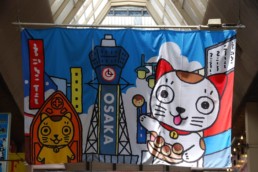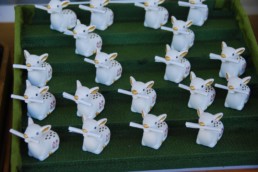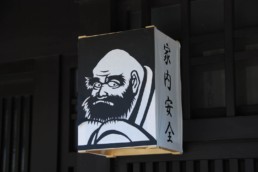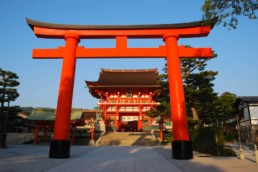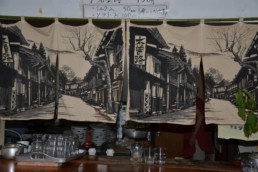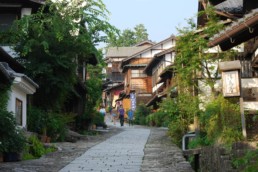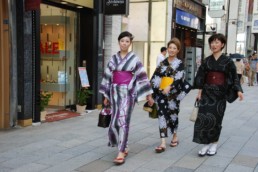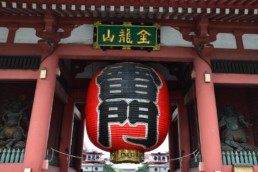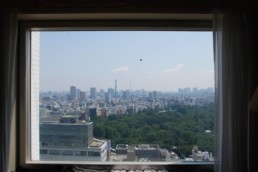We wake up for our 2nd day in Kyoto. Again we choose a western-style breakfast, taking advantage of a buffet offering both Japanese and Western food. We have travelled quite a bit throughout exotic places, but in terms of eating, we find it hard to forgo our western habits for breakfast. We enjoy trying different culinary cultures and local recipes wherever we go during the day. But starting off the day, right out of bed, with a meal which requires to adapt to really different eating habits, is really a challenge for us. I dare to admit: I really enjoy a glass of orange juice, a yogurt, some bread, and a decent cup of coffee for breakfast!!
Today will be dedicated to the visit of the main temples and sanctuaries of Kyoto, except for the Golden Pavilion which we will save for tomorrow.
We start off with the famous Kiyomizu-Dera temple….and alas, we are not alone! A huge crowd of tourists has come to visit this magnificent temple founded in 798 by Sakanone Tamuramaro. The huge building rests on 139 massive wooden pillars. It is really impressive. Located atop a hill, the temple offers a great view of the city of Kyoto. We spend some time watching discreetly the Japanese visitors conducting their prayer rituals.
Next to the temple’s main building, there is a second temple favored by couples or lonely people searching for love, or at last for families who want to pray for happiness, for their children’s well-being, etc. There is a large water fountain where devoted people wait quietly in line for their turn to give their prayers.
We leave the Kiyomizu-Dera temple and head for the Chion-in temple. On the way, we stop at a convenience store to buy some lunch. As we continue our walk, out of luck we encounter a geisha with her young trainee.
They are just magnificent. The colors and patterns of the various pieces of clothing are in perfect harmony. With the elaborate makeup and hairdo, the straight posture, the classy, slow gesture, the sophistication of the geishas is just unbelievable and out of this time. They port a blanket on their knees, probably to shield themselves from the bystanders’ curious looks and against the street dust….it is 35° degrees today!
We continue our walk towards the Chion-in temple which is the home of the Jodo Buddhist sect. The word ‘sect’ refers to a school of thought and belief within the realm of Buddhism. It really has nothing to do with the closed, sectarian groups which we find in our western countries. Unfortunately, the temple is being renovated and therefore is temporarily closed to visitors. Luckily we are able to enter a small temple to the side of the main building, where a family ceremony is under way. We settle down on tatamis and quietly observe the scene. A monk is saying prayers. The atmosphere is so calm and serene.
As the ceremony is ending, we decide to step outside and head for our next stop, the Nanzen-ji temple.
The Nanzen-ji temple was originally founded in 1264 thanks to a donation from emperor Kameyana. It has been rebuilt several times over the centuries, and it features one of the largest wooden gates in Japan.
From this point, we head towards the famous Philosopher’s walk, a long, peaceful walkway which runs alongside a small creek. Except for the cicadas’ songs, the walk is so quiet that we easily forget we are in the city. The pathway is named after the monks from surrounding temples who have been coming here for centuries to meditate. The Philosopher’s walk takes us to Ginkaku-ji, the very famous ‘Silver Pavilion’.
Ginkaku-ji was the residence of Shogun Ashikaga Yoshimasa (1435-1490). Upon his death, the temple was converted to a Zen temple. The building is actually made of wood and was never covered with silver leaves. A magnificent garden, with moss beds and pretty basins, surrounds the pavilion.
This has been an incredible day of sightseeing. We start heading back in the direction of our hotel, walking by the huge Kyoto University campus, and then hop on a bus to reach our hotel for a well-deserved rest.















